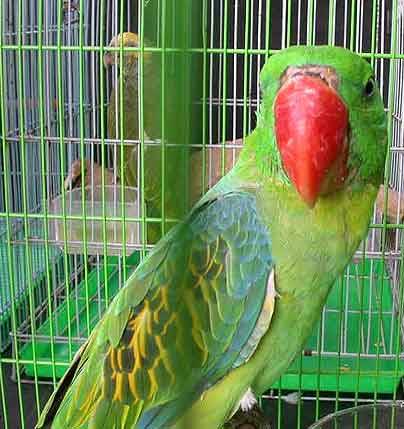
Tanygnathus megalorynchos (Information about this image)
Superregnum: Eukaryota
Cladus: Unikonta
Cladus: Opisthokonta
Cladus: Holozoa
Regnum: Animalia
Subregnum: Eumetazoa
Cladus: Bilateria
Cladus: Nephrozoa
Superphylum: Deuterostomia
Phylum: Chordata
Subphylum: Vertebrata
Infraphylum: Gnathostomata
Megaclassis: Osteichthyes
Cladus: Sarcopterygii
Cladus: Rhipidistia
Cladus: Tetrapodomorpha
Cladus: Eotetrapodiformes
Cladus: Elpistostegalia
Superclassis: Tetrapoda
Cladus: Reptiliomorpha
Cladus: Amniota
Classis: Reptilia
Cladus: Eureptilia
Cladus: Romeriida
Subclassis: Diapsida
Cladus: Sauria
Infraclassis: Archosauromorpha
Cladus: Crurotarsi
Divisio: Archosauria
Cladus: Avemetatarsalia
Cladus: Ornithodira
Subtaxon: Dinosauromorpha
Cladus: Dinosauriformes
Cladus: Dracohors
Cladus: Dinosauria
Ordo: Saurischia
Cladus: Eusaurischia
Subordo: Theropoda
Cladus: Neotheropoda
Cladus: Averostra
Cladus: Tetanurae
Cladus: Avetheropoda
Cladus: Coelurosauria
Cladus: Tyrannoraptora
Cladus: Maniraptoromorpha
Cladus: Maniraptoriformes
Cladus: Maniraptora
Cladus: Pennaraptora
Cladus: Paraves
Cladus: Eumaniraptora
Cladus: Avialae
Infraclassis: Aves
Cladus: Euavialae
Cladus: Avebrevicauda
Cladus: Pygostylia
Cladus: Ornithothoraces
Cladus: Ornithuromorpha
Cladus: Carinatae
Parvclassis: Neornithes
Cohors: Neognathae
Cladus: Neoaves
Cladus: Telluraves
Cladus: Australaves
Ordo: Psittaciformes
Familia: Psittaculidae
Subfamilia: Psittaculinae
Tribus: Psittaculini
Genus: Tanygnathus
Species: Tanygnathus megalorynchos
Name
Tanygnathus megalorynchos (Boddaert, 1783)
References
Table des Planches Enluminéez d'Histoire Naturelle de M. D'Aubenton. p.45
Vernacular names
English: Great-billed Parrot
The great-billed parrot (Tanygnathus megalorynchos) also known as Moluccan parrot or island parrot, is a medium-sized, approximately 38 cm long, green parrot with a massive red bill, cream iris, blackish shoulders, olive green back, pale blue rump and yellowish green underparts. The female is typically smaller than the male, but otherwise the sexes are similar.
The great-billed parrot is found in forest, woodland and mangrove in the south-east Asian islands of Maluku, Raja Ampat, Talaud, Sangir, Sarangani, the Lesser Sundas, and nearby small islands. The diet consists mainly of fruits.
It remains widespread and locally fairly common, and consequently has been rated as least concern on the IUCN Red List of Threatened Species.
Taxonomy
The great-billed parrot was described by the French polymath Georges-Louis Leclerc, Comte de Buffon in 1780 in his Histoire Naturelle des Oiseaux from a specimen collected in New Guinea.[2] The bird was also illustrated in a hand-coloured plate engraved by François-Nicolas Martinet in the Planches Enluminées D'Histoire Naturelle which was produced under the supervision of Edme-Louis Daubenton to accompany Buffon's text.[3] Neither the plate caption nor Buffon's description included a scientific name but in 1783 the Dutch naturalist Pieter Boddaert coined the binomial name Psittacus megalorynchos in his catalogue of the Planches Enluminées.[4] The great-billed parrot is now placed in the genus Tanygnathus that was introduced by the German naturalist Johann Wagler in 1832.[5][6] The generic name combines the Ancient Greek words tanuō "to stretch out" and gnathos "jaw". The specific epithet megalorynchos combines the Ancient Greek megalos "great" and rhunkhos "bill".[7]
Five subspecies are recognized:[6]
T. m. megalorhynchus (Boddaert, 1783) – Sulawesi and nearby islands to Maluku and west Papuan islands
T. m. affinis Wallace, 1863 – south Maluku Islands
T. m. sumbensis Meyer, 1882 – Sumba (east Lesser Sunda Islands)
T. m. hellmayri Mayr, 1944 – Rote Island, Semau and southwest Timor (east Lesser Sundas)
T. m. subaffinis P. L. Sclater, 1883 – Babar and Tanimbar Islands
References
BirdLife International (2016). "Tanygnathus megalorynchos". IUCN Red List of Threatened Species. 2016: e.T22685006A93054419. doi:10.2305/IUCN.UK.2016-3.RLTS.T22685006A93054419.en. Retrieved 12 November 2021.
Buffon, Georges-Louis Leclerc de (1780). "Le perroquet à bec couleur de sang". Histoire Naturelle des Oiseaux (in French). Vol. 11. Paris: De L'Imprimerie Royale. pp. 169–170.
Buffon, Georges-Louis Leclerc de; Martinet, François-Nicolas; Daubenton, Edme-Louis; Daubenton, Louis-Jean-Marie (1765–1783). "Perroquet, de la Nouvelle Guinée". Planches Enluminées D'Histoire Naturelle. Vol. 8. Paris: De L'Imprimerie Royale. Plate 713.
Boddaert, Pieter (1783). Table des planches enluminéez d'histoire naturelle de M. D'Aubenton : avec les denominations de M.M. de Buffon, Brisson, Edwards, Linnaeus et Latham, precedé d'une notice des principaux ouvrages zoologiques enluminés (in French). Utrecht. p. 45, Number 713.
Wagler, Johann Georg (1832). "Monographia Psittacorum". Abhandlungen der mathematisch-physikalischen Classe, Königlich-Bayerische Akademie der Wissenschaften (in Latin). 1: 463–750 [501].
Gill, Frank; Donsker, David, eds. (2019). "Parrots, cockatoos". World Bird List Version 9.2. International Ornithologists' Union. Retrieved 11 August 2019.
Jobling, James A. (2010). The Helm Dictionary of Scientific Bird Names. London: Christopher Helm. pp. 245, 379. ISBN 978-1-4081-2501-4.
Retrieved from "http://en.wikipedia.org/"
All text is available under the terms of the GNU Free Documentation License

